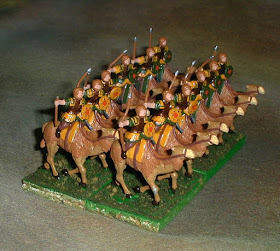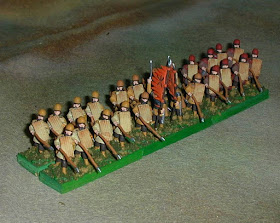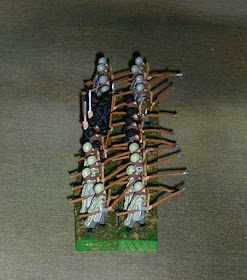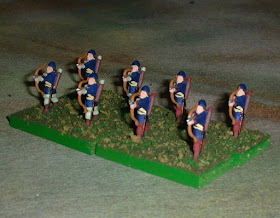My Palmyran army is one of those I painted back in the late 1970's. Until the recent, utterly contemptible acts of the so-called Islamic State in Syria, I'd venture that 99% of the world's population has probably never even heard of the place, but its history stretches back to the Neolithic era. It is located 134 miles Northeast of Damascus, in an oasis surrounded by 20 species of palm trees, with mountains on two sides.
Its existence was first documented in the second millennia BC as a caravan stop, under the ancient name of Tadmur, It is mentioned in both Assyrian records and, possibly the Old Testament of the Bible as well. It was part of the Seleucid Empire (a Macedonian successor state in the Middle East), and became part of the Roman Empire in the first century AD. The name "Palmyra" was first ascribed to the city by the Roman historian Pliny in 70 AD. The name may refer to the Palm trees surrounding the city. Pliny noted it as being " famous for its desert location", "the richness of its soil", and "the springs surrounding it, which made agriculture and herding possible"
The happiest narrative of her fate in Rome holds that Aurelian, impressed by her beauty and dignity and out of a desire for clemency, freed Zenobia and granted her an elegant villa in Tibur (modern Tivoli) She supposedly lived in luxury and became a prominent philosopher, socialite and Roman matron. Zenobia is said to have married a Roman governor and senator whose name is uncertain.
Its existence was first documented in the second millennia BC as a caravan stop, under the ancient name of Tadmur, It is mentioned in both Assyrian records and, possibly the Old Testament of the Bible as well. It was part of the Seleucid Empire (a Macedonian successor state in the Middle East), and became part of the Roman Empire in the first century AD. The name "Palmyra" was first ascribed to the city by the Roman historian Pliny in 70 AD. The name may refer to the Palm trees surrounding the city. Pliny noted it as being " famous for its desert location", "the richness of its soil", and "the springs surrounding it, which made agriculture and herding possible"
The city prospered under Roman rule as a semi autonomous region, reaching an estimated population of 200,000 people. The rise of the Sassanid Persian empire caused a significant drop of in the trade that was the economic engine of the city state, leading the city to appoint a Lord in the form of Odeanathus, circa 252 AD. Doubtless a chief motivation for this step was to strengthen the Army to better defend against the Sassanids.
Given the city's location and history, it is hardly surprising that Camel mounted troops formed a part of its army.
There is reason to believe the Palmyran camelry fought more as close order troops than the more common mounted skirmishers usually encountered in Arab forces.
Horses famously dislike the scent of these "Ships of the Desert", and cavalry unused to them could be thrown into disorder by their "dreaded smell factor"!
Odeanathus sought guarantees of Palmyran interests within the Sassanid Persian territories, but his requests were rejected.
In 260 AD, Emperor Valerian lead a Roman army against Shapur I of Persia, but was soundly defeated at the Battle of Edessa, and was captured.
Odeanathus raised an army from the citizens of Palmyra, surviving Roman troops, and peasants in the area. many of which were drafted into units of Levy spearmen such as those seen above.
Odeanathus proclaimed himself King of Palmyra, and marched against the forces of Shapur.
The Sassanid Persians were defeated decisively in a battle near the Euphrates river, and forced to retreat.
The Roman empire was weak at this time, and one of Valerian's generals rebelled against Valerian's son, and assumed Imperial power for themselves in Syria.
In 261 AD, Odeanathus attacked the Syrian usurpers and defeated them,
Gallenius, Valerian's son, awarded Odeanathus the title of Imperator Totius Orientis ("Governor of all of the East") .
As Imperial representative, Odeanathus ruled Syria, Mesopotamia, Arabia, and part of Anatolia.
The core of the Palmyran army were its units of very heavily armored Cataphract cavalry, such as those seen above.
The men were almost completely armored, often wearing bronze face masks, and their horses were similarly protected.
They fought with the lance, and typically carried maces as well, which were well suited for combating heavily armored foes, such as the Sassanid Clibanophori.
Unlike their Persian enemies, these Palmyran Cataphracts appear not to have used the bow.
In 262 AD, Odeanathus began a new campaign against Shapur I, reclaiming the rest of Roman Mesopotamia, and even besieging the Persian capitol, Ctesiphon.
Following these new successes, he proclaimed himself "King of Kings", the traditional title of Persian monarchs.
King Odeanathus defeated the Persians yet again in 263 AD.
Thereafter, he crowned his son co-King of Kings, and besieged the Persian capitol for the second time in 264.
Although the siege failed, the Palmyrans succeeded in regaining all the Roman lands lost to Shapur since 252 AD.
Odeanathus and his army defeated a Persian attack on the city in 266 AD, and the Persians were defeated yet again near Ctesiphon.
Gothic attacks upon Asia minor were met by a Palmyran army under Odeanathus and his son, Hairan in 267 AD.
Foot Archers played an important supporting role in the Palmyran army.
They appear to have been organized on a more permanent basis than the peasant levy spearmen.
On their return trip from Asia minor, both Odeanathus and his son and co-ruler were assassinated by a relative (cousin or nephew), in the time honored fashion of Eastern despots!
The assassin was tried and executed in short order by Odeanathus' widow, Zenobia.
Odeanathus was survived buy two more sons, these by his second wife (Zenobia), one only 10 years old, and the third, who died soon after, even younger.
Thus Zenobia became regent and de facto ruler of Plamyra and the Roman Middle East.
Emperor Gallienius sent a Roman prefect to command the combined Roman and Palmyran forces against the Persians, but he could do little without cooperation form Queen Zenbia, and he was ultimately recalled.
She took care not to aggravate the Romans, claiming only the titles formerly held by her husband for herself and her son.
There were evidently further Palmyran conflicts with the Sassanid Persians, and fortified citadels were constructed to protect the borders. .
In 269 AD, Odeanathus' surviving son, Vallbalatus, claimed the title Persicus Maximus ("The great victor over Persia").
In 270 AD, Zenobia herself went on campaign, conquering Roman Arabia and invading Egypt, crowning herself Queen of Egypt as well. This took place during the short reign of Emperor Claudius Gothicus.
In 271, Zenobia and her army invaded Anatolia, reaching as far as Ankarra. This marked the maximum expansion of Palmyran territory.
The Palmyrene Empire at its greatest extent.
These conquests were made under the pretense of subordination to Rome.
The Palmyran army also included two types of fairly "regular" light cavalry; seen above are the Javelin and shield armed version.
The new Roman Emperor, Aurelian, allowed this charade while he was occupied fighting rebellions in Europe.
In late 271 AD, Zenobia crowned herself and her son Vallabathus as Augusta and Augustus (Emperor).
In 272 AD, Emperor Aurelian crossed the Dardanelles with a Roman army and marched swiftly through Anatolia.
The bow armed version of Palmyran Light cavalry is seen above.
The Romans reconquered Egypt, "the Breadbasket of the Empire", and went on to defeat Zenobia at the Battle of Immae, and then a second time at the Battle of Emessa.
Zenobia returned to Plamyra, but refused a demand to surrender directly to Aurelian as he placed the city under siege. She escaped to look for assistance from the Persians, but was captured by the Romans. She and Vallabtus were taken back to Rome. Her son died, either along the way or shortly after arriving in Rome. Zenobia's fate is less certain. She was said to be strikingly beautiful and highly intelligent, fluent in Greek, Egyptian and Aramaic. She claimed to be descended from both Cleopatra and Queen Dido of Carthage.
The happiest narrative of her fate in Rome holds that Aurelian, impressed by her beauty and dignity and out of a desire for clemency, freed Zenobia and granted her an elegant villa in Tibur (modern Tivoli) She supposedly lived in luxury and became a prominent philosopher, socialite and Roman matron. Zenobia is said to have married a Roman governor and senator whose name is uncertain.
As for Palmyra itself, Aurelian spared the city and established a small Roman garrison there.
Palmyra rebelled against Roman rule once more in 273, appointing a relative of Zenobia's as Emperor. Aurelian returned and defeated the Palmyrans yet again. This time, the city was not so fortunate, and Aurelian razed it to the ground, massacring many of its residents.
In the following decades, Palmyra, reduced to a village, became a Christian settlement. In 527 Emperor Justinian ordered the restoration of many of the city's buildings, and its fortification as a bastion against the foes of Rome to the East.
Palmyra became part of the Rashidun Caliphate in 634 AD. Over the following centuries it was ruled by many others, including the Mamelukes and the Ottoman Empire. It became part of the new state of Syria following the end of World War I (1920).
A final shot of my entire Palmyran army. These are all vintage Minifigs. Perhaps the shades of the ancient warriors depicted here will rise to seek retribution for the defilement of the remains of the city, which once challenged the mighty Roman empire itself!
This brief synopsis of Palmyran history was paraphrased from the excellent Wkikipedia article on Palmyra, Go there for pictures of the remains of the city, some of which were destroyed just this month, and others looted earlier this year. Even worse, the world's foremost expert on Palmyra, a Syrian scholar who studied it, protected it, and lived there for over 50 years was tortured and killed just this past week. Words fail me to adequately express the profound revulsion such acts, falsely perpetrated in the name of religion, must prompt in any reasonable person.



















































